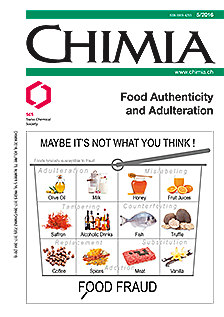Food Adulteration: From Vulnerability Assessment to New Analytical Solutions
DOI:
https://doi.org/10.2533/chimia.2016.329Keywords:
Adulteration, Fraud, Meat, Milk, Nitrogenous compoundsAbstract
Crises related to the presence of melamine in milk or horse meat in beef have been a wake-up call to the whole food industry showing that adulteration of food raw materials is a complex issue. By analysing the situation, it became clear that the risk-based approach applied to ensure the safety related to chemical contaminants in food is not adequate for food fraud. Therefore, a specific approach has been developed to evaluate adulteration vulnerabilities within the food chain. Vulnerabilities will require the development of new analytical solutions. Fingerprinting methodologies can be very powerful in determining the status of a raw material without knowing the identity of each constituent. Milk adulterated by addition of adulterants with very different chemical properties could be detected rapidly by Fourier-transformed mid-infrared spectroscopy (FT-mid-IR) fingerprinting technology. In parallel, a fast and simple multi-analytes liquid-chromatography tandem mass-spectrometry (LC/MS-MS) method has been developed to detect either high levels of nitrogen-rich compounds resulting from adulteration or low levels due to accidental contamination either in milk or in other sensitive food matrices. To verify meat species authenticity, DNA-based methods are preferred for both raw ingredients and processed food. DNA macro-array, and more specifically the Meat LCD Array have showed efficient and reliable meat identification, allowing the simultaneous detection of 32 meat species. While the Meat LCD Array is still a targeted approach, DNA sequencing is a significant step towards an untargeted one.Downloads
Published
2016-05-25
Issue
Section
Scientific Articles
License
Copyright (c) 2016 Swiss Chemical Society

This work is licensed under a Creative Commons Attribution-NonCommercial 4.0 International License.
How to Cite
[1]
C. Cavin, G. Cottenet, C. Blancpain, T. Bessaire, N. Frank, P. Zbinden, Chimia 2016, 70, 329, DOI: 10.2533/chimia.2016.329.







